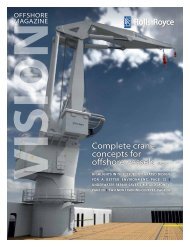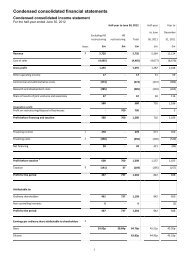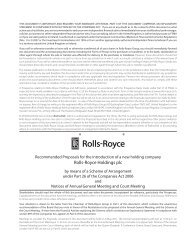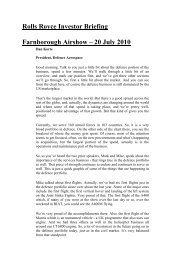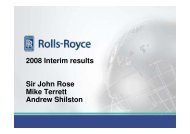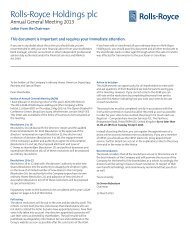Vision 2009 - Rolls-Royce
Vision 2009 - Rolls-Royce
Vision 2009 - Rolls-Royce
Create successful ePaper yourself
Turn your PDF publications into a flip-book with our unique Google optimized e-Paper software.
‘Computer game’<br />
with real consequences<br />
At first glance today’s dynamic positioning (DP) unit, with the cool joystick, looks like it comes from the<br />
latest computer game. But this is no game. The technology is state-of-the-art, and the need for proper<br />
training is considerable.<br />
Market outlook BROKERS CORNER<br />
Far East<br />
North Sea<br />
26<br />
VISION 1-<strong>2009</strong>. <strong>Rolls</strong>-<strong>Royce</strong><br />
C<br />
Part of the project team establishing a new<br />
training facility for DP. Training Manager Tron<br />
R. Resnes, Team Manager Geir Olav Otterlei<br />
and Project Manager Erlend Rangnes.<br />
“We get phone calls every week<br />
from shipping lines and vessels<br />
asking for the latest know-how on<br />
DP,” says Geir Olav Otterlei, Team<br />
Manager with Marine Services at<br />
<strong>Rolls</strong>-<strong>Royce</strong>, Control – Ålesund.<br />
“So our training programmes<br />
are definitely in demand. And,<br />
increasingly, training is included as<br />
part of the sales agreement when<br />
customers order DP systems.”<br />
<strong>Rolls</strong>-<strong>Royce</strong> is currently expanding<br />
its DP training capacity, and will be<br />
opening a new training laboratory<br />
during the year. The new facilities<br />
will allow <strong>Rolls</strong>-<strong>Royce</strong> to offer<br />
training to groups of up to 10<br />
people at a time.<br />
When the new <strong>Rolls</strong>-<strong>Royce</strong><br />
Training Centre in Ålesund goes<br />
into operation it will also include a<br />
DP classroom. Until then the first<br />
version will be installed close by, at<br />
Ålesund University College.<br />
‘Game over’?<br />
DP links together familiar systems<br />
that can be operated by means of a<br />
monitor and joystick arrangement.<br />
You can, quite simply, sit in comfort<br />
on the bridge and keep the vessel<br />
correctly positioned – on station<br />
beside an oil rig, for example. How<br />
much training does that really take?<br />
“It is precisely the fact that DP<br />
links together so many automated<br />
systems and processes on board<br />
that makes correct handling so<br />
important. Let’s put it this way:<br />
when it’s ‘game over’ on a computer<br />
game you just start again. For a real<br />
ship it would probably mean a visit<br />
from the service engineer or a trip<br />
into dock,” explains Otterlei.<br />
In addition to crew training,<br />
<strong>Rolls</strong>-<strong>Royce</strong> also runs courses for key<br />
service personnel.<br />
Training manager<br />
In the ‘good old days’ seamen were<br />
‘jacks of all trades’, able to turn<br />
their hands to more or less any job<br />
on board. And they learned their<br />
skills as they went along. But as<br />
vessels have become ever more<br />
technologically advanced, the need<br />
for specialised training has steadily<br />
increased. At the same time, more<br />
C<br />
The classroom plan for the DP training laboratory to be<br />
established by the summer of <strong>2009</strong>.<br />
than one member of the crew must<br />
be capable of performing any given<br />
task. Every DP system supplied<br />
by <strong>Rolls</strong>-<strong>Royce</strong> will be handled by<br />
12 people – if crew members are<br />
operating a two-watch pattern.<br />
“We have orders for 31 new DP<br />
systems and 60 new joysticks for<br />
delivery in <strong>2009</strong>. It goes without<br />
saying that the need for training is<br />
enormous,” says Otterlei.<br />
<strong>Rolls</strong>-<strong>Royce</strong> has recruited a new DP<br />
training manager. Tron R Resnes has<br />
experience as both second officer<br />
and crewman on offshore vessels,<br />
and as a classroom instructor.<br />
“The people who develop these<br />
systems, myself included, are<br />
technocrats. We need more teaching<br />
skills. Being able to explain things<br />
and understanding the user’s point<br />
of view are important to the success<br />
of any training programme. That is<br />
why we are extremely pleased that<br />
Tron has taken on this role,” says<br />
Otterlei.<br />
One of Resnes’s first tasks will be to<br />
further develop the course material<br />
and tutorials. A<br />
What is the market like now<br />
and what is the outlook for the<br />
next few months? Two brokers<br />
give their views. Note that the<br />
respones were given in mid<br />
April <strong>2009</strong>.<br />
Robert Henley is a broker at the R.S.<br />
Platou Shipbrokers office in Singapore.<br />
In the market, perhaps least touched<br />
by financial turbulence, business is as<br />
usual. Or better.<br />
The final quarter of 2008 gave the first<br />
real signs of the financial turmoil<br />
affecting the SE Asian supply vessel<br />
market. Cancellations of new builds<br />
have become a reality, S & P activity has<br />
decreased dramatically and Charterers<br />
have moved from the position of<br />
beggars to choosers. An influx of<br />
vessels in the spot market has given<br />
softening of rates in the short term,<br />
and we see more and more owners<br />
being willing to drop levels to secure<br />
comfortable term work.<br />
Sale and purchase activity has more<br />
or less come to a standstill, with<br />
virtually no financing obtainable in<br />
the market. There are still plenty of<br />
buyers out there, but unless the banks<br />
reopen their doors, few deals are likely<br />
to be concluded during the first half of<br />
this year – especially on USD 10 mill. +<br />
units .<br />
With today’s ‘low’ oil price, most<br />
charterers have been hesitant to take<br />
on vessels at 2008 rates which have<br />
resulted in a correction. Some may<br />
argue owners were a bit late in taking<br />
their share of ‘it’ in order keep oil<br />
companies’ investments at a healthy<br />
level and maintain demand at decent<br />
levels. Some of the oil minnows and<br />
even majors will and have proven to<br />
struggle to execute their intended<br />
plans as a result of reduced oil price<br />
and unsecured financing for their<br />
planned programmes. A<br />
Bruse Kverneland works at Seabrokers<br />
Chartering AS in Stavanger.<br />
The offshore market saw an incredibly<br />
strong last period of 2008, with record<br />
high rates on large AHTS. We still<br />
believe that the rate levels for <strong>2009</strong><br />
will stay strong, but with greater<br />
fluctuations than in 2008.<br />
<strong>2009</strong> started out with a lot of available<br />
tonnage, but this situation has<br />
gradually tightened. In the course of<br />
a few months, 10-12 large AHTS will<br />
disappear from the North Sea, and<br />
this will further limit the availability of<br />
tonnage.<br />
One must always take into account that<br />
projects could get cancelled at short<br />
notice, due to low oil prices or the<br />
financial turmoil in general – this will of<br />
course alter the situation.<br />
The credit market is still struggling,<br />
with even great projects meeting<br />
difficult obstacles. But there is still<br />
optimism among the players in the<br />
market. A<br />
27<br />
VISION 1-<strong>2009</strong>. <strong>Rolls</strong>-<strong>Royce</strong>




